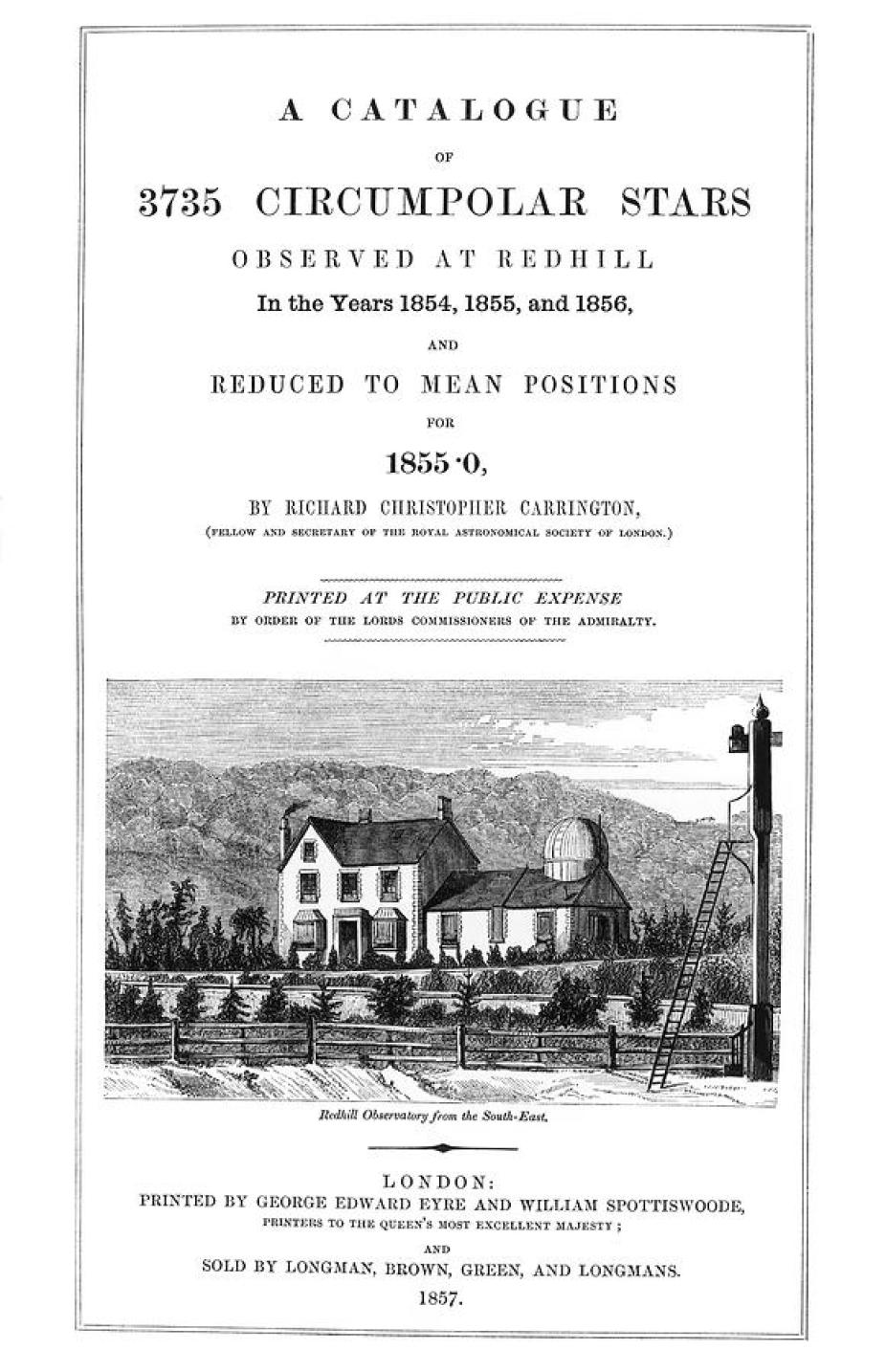Richard Christopher Carrington (1826–1875)
Richard Christopher Carrington was born on May 26, 1826 in Chelsea, England. The second son of a wealthy brewer, Carrington was originally expected to pursue a career in the Church. He began studies in theology at Trinity College Cambridge, where he graduated in 1848. By then, however, Carrington had found his true vocation in astronomy.

Cover image of Richard Christopher Carrington's Catalogue of Circumpolar Stars.
In 1849 he joined the Durham University Observatory, but resigned this position in three years later and used his family fortune to build his own house and observatory at Redhill, Surrey. There, he engaged in both day time solar and night time astronomical observations, until the death of his father in 1858 forced him to take over the family business. He was elected to the Royal Astronomical Society in 1851 and to the Royal Society in 1850.
Although his work on asteroids and planets while at Durham University Observatory was enough to secure membership in the Royal Astronomical Society, Carrington's first major astronomical undertaking was the compilation, between 1854 and 1857, of his "Catalogue of 3735 Circumpolar Stars." Published in 1857, Carrington's Catalogue was highly praised and earned him the Gold Medal of the Royal Astronomical Society.
Carrington is primarily remembered for his pioneering work on sunspots. Impressed by Heinrich Schwabe's 1843 discovery of the sunspot cycle, and appalled by the lack of systematic sunspots observations, Carrington took it upon himself to pick up the subject where Schwabe had left it. Improving on Schwabe's projection/drawing method, Carrington drew and recorded the positions of sunspots from 1853 to 1861. Although he failed to cover a full sunspot cycle, as originally intended, he nonetheless reaped a rich harvest from his observations, including (1) the discovery of the Sun's differential rotation, (2) the equatorward migration of spots in the course of the cycle (both of these more-or-less simultaneously and independently discovered by Gustav Spörer in Germany), (3) the determination of the Sun's rotation axis with an accuracy previously unprecedented, and (4) the first and serendipitous observation of a white-light flare.
By the time Carrington published his massive 1863 sunspot tome, entitled "Observations of the Spots on the Sun," he was already recognized worldwide as the British authority on sunspots. He carried out extensive correspondence with sunspot observers across Europe, including Heinrich Schwabe and Rudolf Wolf. When Schwabe was awarded the Royal Astronomical Society's Gold Medal in 1857, Carrington personally delivered the medal to the aging German astronomer, and later persuaded him to donate his extensive collection of sunspot drawings to the Society's Archives.
Despite these successes, in the early 1860's Carrington failed in his bid to secure the directorship of Cambridge Observatory, in succession to his former astronomy teacher James Challis. Bitterly disappointed, Carrington put an end to his astronomical work at Redhill. Both his health and his marriage degraded from that point on, culminating in November 1875 with the death of his wife from a drug overdose. Ten days later, Carrington himself died, officially of a brain hemorrhage.
Bibliography
Porter, R. (ed. ) 1994, The Biographical Dictionary of Scientists, Oxford University Press.
Forbes, E. G. , The Dictionary of Scientific Biographies, 1980–1990, New York.
Meadows, A. J. 1970, Early Solar Physics, Pergamon.